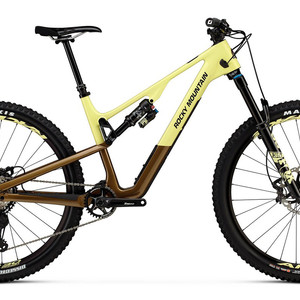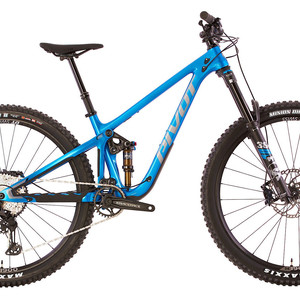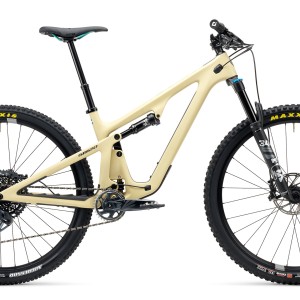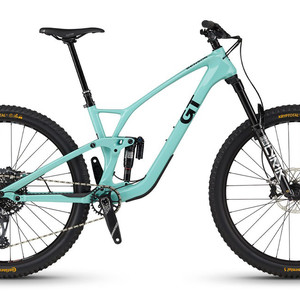2013 Mondraker Foxy XR
(discontinued)
| Where To Buy | |||
|---|---|---|---|
Free shipping on orders over $50 (continental U.S. only).
International shipping available. Some exclusions apply. |
|||
Free shipping on orders over $50 (continental U.S. only).
International shipping available. Some exclusions apply. |
|||
Reviewed by Steve Wentz, Joe Schneider, and Brandon Turman // Photos by Shawn Spomer and Brandon Turman
With its unique "Forward Geometry" and super short 10mm stem, the Mondraker Foxy XR was perhaps the most unique ride in the 2013 Vital MTB Test Sessions lineup. Billed as an all-mountain bike (that's important given that Mondraker also has trail and enduro bikes), the Foxy XR has 140mm of rear travel, a 67-degree head angle, and a massive wheelbase. Mondraker says they made this ride capable of pedaling up and rallying down, and rally we did! In fact, this may have been the most rally-able all-mountain bike we've ever ridden…

Foxy XR Highlights
- Stealth Side Alloy Structure with Forward Geometry frame
- 26-inch wheels
- 140mm (5.51-inches) of rear wheel travel
- Tapered head tube
- 67-degree head angle
- 74-degree seat angle
- +6mm bottom bracket offset
- 430mm (16.9-inches) chainstay length
- Standard thread-in bottom bracket with ISCG05 chainguide mounts
- Direct mount front derailleur
- 12x135mm rear dropouts
- Medium and Large sizes only
- Measured Weight: (size Medium) 29-pounds, 11-ounces (13.5 kg)
- ~$6,000 MSRP (£3,999.00)
First, let's make the distinction between Mondraker's other Foxy models. Of the four, the "XR" model is the only one to use the new Forward Geometry concept, plus it gets a dose of awesome with the addition of 20mm additional fork travel (up to 160mm), a Maxle through axle, ISCG05 tabs, dropper post, wider tires, and a revised shock-tune with lower compression compared to the models. That said, it's one burly bike.
To back up the burliness, the frame itself is designed with Mondraker's "Stealth Technology," which is essentially a different way of doing things, and is characterized by flat faces and sharp edges as opposed to the traditional curved or rounded shapes. This is most obvious when looking at the linkage and dropout areas. Weight is an important consideration during the process, and the use of butted tubing and a different aluminum alloy help to keep it light and stiff, especially in high stress areas.

Now then, the truly exciting bit - Forward Geometry. Designed by Cesar Rojo with the help of Fabien Barel, Mondraker took the longer top tube/shorter stem trend to the extreme, extending the top tube and shortening the stem length a massive amount. In the case of our size Medium test bike, the front triangle was lengthened 60mm when compared to the Foxy RR, a conventional looking bike with the same amount of travel and head angle. When you consider that the RR has a 70mm stem and the XR has a 10mm stem, you'll realize that the handlebars are in the same position in relation to the bottom bracket and saddle.Why not a 0mm stem? Because Mondraker found that a small amount of bias toward the front of the bike is needed to help keep the front wheel tracking in the right direction. As a comparison, motocross bikes are setup with a similar amount of forward bias.
Mondraker says that the extended forward-center measurement (that's the distance between the bottom bracket and front axle) helps improve the control, handling and riding confidence. Keep reading to see if that's what we experienced…
Note that you'll have to pick a bar height and stick with it, because unfortunately, steerer tubes don't grow back and the stem has to go on top of all the spacers. One other drawback to the system is the need to remove the bars from the stem to be able to tighten the headset.

Out back, the Foxy XR utilizes Mondraker's Zero Platform for suspension duties. As a virtual pivot system, the rear shock floats between two rotating links that both compress the shock. The "Zero" name likely comes from the advantages claimed by the system, including zero power loss (suspension is unaffected), zero pedal kickback (minimal chain growth), zero brake jack, and zero bumps (thanks to the rear wheel trajectory and leverage curve).
While we appreciate the low center of gravity offered by the Zero system, shock access is limited, making it harder to set the sag point. The shock is also on the firing line should you encounter any mud. Speaking of mud, there's very little rear tire clearance, perhaps just 1/8-inch in the worst spot.
Finally, the frame has a flip chip style adjustment in the upper rocker link to slightly adjust the head angle and bottom bracket height, which is very clean and almost seamless with the other pivots. For Test Sessions, we chose to leave it in the slack and low mode, just to see what this beast was really made of.
On The Trail
Knowing that the bike would likely excel in the gnar, Steve pointed it straight down Grafton Mesa, perhaps the roughest all-mountain worthy trail near Hurricane, Utah. At the same time, we were curious how it would perform on mellower, every day type of trails, so Joe and Brandon pedaled it down the popular and flowy JEM Trail.
Between the wheelbase measuring a whopping 47.2-inches on our Medium test bike (that's longer than many downhill bikes), the 25.4-inch top tube, and the super short 10mm stem length, we knew we were in for something special - just pedaling around the parking lot had a very unique feel. While the cockpit was very comfortable, on the medium to long side, and quite centered, the tiny stem took some time to get used to. The bike had an unusually slow handling feeling, much like a downhill bike with a slack head angle and 50mm stem. After a few minutes of messing about, we were used to the sensation and ready to unleash it.

Because we rode the bike on two very different trails, our accounts of the bike's handling characteristics varied. Pointed down the rowdy Grafton Mesa trail, immediately up to speed and into the gnar, here's Steve's recount of the descents:
"Once on the trail, I felt comfortable right off the bat. The bar height was comfortable and because of the slower steering, I felt like charging into sections right away, with a lot of confidence entering rough sections. I had to be conscious of weighting the front wheel when riding, or else some push would occur, but it was very predictable when it happened. Because I was weighting the front wheel, and I felt comfortable getting forward on the bike, I felt the back end dance around a little in rough stuff - check the ONE LAP footage for reference. Overall, it was resoundingly comfortable and confidence inspiring… more so than any other bike I've recently hopped on.
The confidence thing is a double edged sword though. The bike was playful - I could push through the suspension and move the bike around easily - but at the speeds the geometry allowed me to reach (DH speeds), the proverbial shit hit the fan when hitting lots of bumps in succession.That said, we'd likely never reach quite the same speeds on a "normal" bike.I felt like I was close to the limit quickly in the roughest sections, and then my confidence, which was high, got shot back down. It's a 140mm travel bike that feels more on the 125mm travel side when things get really rough. The bike would move through its travel and just stay there. I tried faster rebound, and at different times more compression, and the bike would spring up too much in the last part of the travel, like an uncontrolled top out without the clank or official top out sound.
Small bumps were just okay - nothing super smooth, nothing bad. Square edge hits were taken well, too. Chatter, g-outs and drops were the only area where I had trouble. When I would really go for it, and the trail was smooth without successive hits, it was amazing. I could push through the majority of the travel and the middle to bottom was very predictable and good. This tendency also made the bike jump very well. I liked the predictability of pushing through compression to get to the solid bottom.
I will say that compared to other bikes in the category, the Mondraker is almost too suited to being over ridden, which I feel the bike needs to be ridden like to excel. The Forward Geometry is great for going fast - it's VERY stable, and because of that the bike will tempt you into wanting to go even faster. The relaxed head angle made the bike feel anything but twitchy, so I think I was going faster than I actually felt. It's just the suspension that needs some work. More compression, high/low speed rebound or a good ol' coil shock could really help this area. It felt progressive and went through some travel rather quickly (sometimes too quickly), then ramped up very fast near the end. I'd love to race this at a Sea Otter Classic DH course, and just take the few hits that there are, but not a Porcupine Rim style trail with lots ofsuccessivemedium hits over a multiple hour ride."

Joe and Brandon's experience while descending on the smoother, less steep JEM Trail was a bit different:
"Right off the bat, while pedaling through a tight, turny, gradually downhill section of trail filled with small rolling hills, the bike felt like a handful. In fact, it felt like we were on a downhill bike, both from the geometry and rolling speed perspectives. Luckily it pedaled much better than a downhill bike.
At slow speeds, the front end was slack enough (or far enough forward?) that the bike would push in turns. Tight, slow turns were made more difficult by the elongated wheelbase, and jumping the bike at moderate speeds wasn't really happening without a lot of body english. It liked to hug the ground, and felt a bit dead until you hit warp speed. In general, you really had to get over the front end and get after it for the bike to excel, and unfortunately the majority of the trail we rode wasn't a trail conducive to that style of riding.
In the bits where speed was plentiful, the Foxy XR's benefits began to shine through. The long wheelbase made both the smooth and rough bits more enjoyable, with a fun and flickable feel. The steeper and rockier it got, the more it felt at home and the better it handled. Leaning the bike into turns was awesome, and there was an incredible amount of stability. It just tracked right along without hesitation. Stiffness in the rear end was also a non-issue. We did notice, though, that hopping between lines, even at speed, was markedly slower than most bikes.
Suspension wise, the Foxy XR fared pretty well over most terrain types. Small bumps were decent, square edge hits were okay, and the few drops along the trail were stable. There was an odd sensation of being a bit over-damped at times. Also, there was some rather uncontrollable sideways skipping while under power and over the front end in a few chattery sections, and we weren't overly impressed by the bike's ability to track through sections like this.
Of note, the bike really benefitted from the 'Descend' mode setting on the FOX CTD rear shock, which is kind of rare. Combined with the over damped feeling we experienced on the trail, we decided to pull the rear shock once done with the ride. We found that the bike had a binding issue (sticky feeling), especially at the beginning of the stroke. There was also a lot of DU bushing rotation, which may have added to the sensation."

Pointed uphill, opinions among the group were pretty consistent. Perceived weight was neither light or heavy. Rolling speed was decent, but the wide tires slowed things a bit, making you have to really work for it on sustained climbs and rolling sections. Bob during out of the saddle sprints was never an issue, and the bike felt like there was zero wasted energy in the biggest chainring.
Seated climbs did expose some bob in the granny gear if we weren't pedaling smoothly. That said, this is a bike that's a prime candidate for a 1X setup, so having a 34/36 tooth main gear and a larger cassette could mitigate the suspension's minor flaws in the small chainring. Body position felt good and comfortable, but the front end did wander a little bit as was expected. Dropping the FOX Talas CTD fork to the lower travel setting helped alleviate the issue, improving handling in tight uphill switchbacks. The wheelbase was long enough that timing on ledges and other tricky maneuvers had to be altered slightly, which isn't a bad thing, it was just different. On steep climbs, when we'd really get over the front end, the Forward Geometry did create an awkward, twitchy feeling.
Build Kit
Let's get the bad out of the way first, shall we? The Crankbrothers Kronolog seatpost simply didn't cut it. In fact, it failed completely on ride three, and wouldn't hold itself up if it was set to any of the middle positions. Additionally, it's hard to actuate and the action slows over time.We did enjoy the Fizik Gobi XM saddle though, which is a standout on the build.
At roughly $6,000, aside from the post, we were mostly pleased with the spec list. It's well suited to the all-mountain rider.
Formula's The One S brakes had plenty of power, but a little more initial bite would have been welcome. Additionally, there was some slight howl at times.

After Steve's experience on Grafton Mesa, he suggested that a dual stage rebound would help to control the bike, and in his opinion, a coil shock is what the bike really needs. The FOX Float CTD shock tried to do well, but it got overwhelmed when ridden how this bike should be ridden.
As for the front, the FOX Talas CTD also left a little to be desired. The fork was too stiff off the top, which could be due to the additional seals in the Talas system. Steve had to run it on the limit of too soft to make the top tolerable, and that made the fork go through the travel a bit too freely. At the expense of losing the adjustability on climbs, aFloat fork could help save weight and stiction. That said, the bike isn't particularly suited to technical climbing and long uphill jaunts anyway.
Tire performance was decent, and again depended on the trail. Steve's experience had him wanting a smaller tire with a more stout casing to get a similar weight and avoid the springy feeling of the 2.35-inch Schwalbe Hans Dampfs. Otherwise, we found grip to be good and they were predictable.
The CrankBrothers Iodine 3 wheels were plenty stiff, durable, and the back end went exactly where we wanted it.
Shifting with SRAM's X0 Type II rear derailleur was good, with no skips, dropped chains, or drag. Chain noise was rarely an issue, but a quick wrap on the inside of the seatstay would help when in the smallest cogs. Up front the bike is equipped with a 2X system and Shimano XT shifter. Performance here was good as well.
Long Term Durability
Save the Kronolog seatpost, we see no obvious long term concerns with the components. The frame looks stout as well, and we wouldn't be too worried about anything going awry. Super aggressive riders on aggressive trails (this bike's speciality) may overtax the rear shock after a while.

What's The Bottom Line?
The Forward Geometry offered by the Mondraker Foxy XR creates a bike that wants to be ridden really, really hard, and can to be to a point. Compared to similar 140mm travel bikes it's by far the most aggressive of the bunch, and it excels when being pushed in almost any terrain. This comes with a price, though, as the rear suspension may not keep up for riders that use the bike to its full potential (we're talking DH speeds here, because the bike will allow it).
In general, the Foxy XR rewards an active rider, and will punish you if you keep in the saddle or hover over the middle, making it a less than ideal candidate for pedally rides. That said, we think it would be incredible in loamy, steep, fast trails, or those that are wide open where stability is key and other bikes can't offer it. This is one of a few bikes that we've ridden with a minimum speed limit, and we dig it, provided you're on a trail that suits that kind of bike.
For more details, head over to www.mondraker.com.
Editor's note: After further consideration of our testers' notes, the decision was made to modify the rating from 4 stars (excellent) to 3 stars (good). On the right trails this bike can be amazing, but for the sake of consistency the rating needs to take into account the bike's overall performance and all-mountain designation.
Bonus Gallery: 32 photos of the 2013 Mondrakery Foxy XR
About The Reviewers
Steve Wentz - A man of many talents, Steve got his start in downhilling at a young age. He has been riding for over 17 years, 10 of which have been in the Pro ranks. Asked to describe his riding style he said, "I like to smooth out the trail myself." Today he builds some of the best trails in the world (and eats lots of M&M's).
Joe Schneider - During the day, Joe's busy solving complex mechanical engineering problems. When he's free, he's out crushing miles on his bikes and moto. He raced cross-country for several years, made an appearance on the Collegiate National Champs Omnium, turned Pro, and more recently shifted his focus to enduro.
Brandon Turman - Brandon likes to pop off the little bonus lines on the sides of the trail, get aggressive when he's in tune with a bike and talk tech. In 13 years of riding he worked his way through the Collegiate downhill ranks to the Pro level. Nowadays he's Vital MTB's resident product guy.
Specifications
| Where To Buy | |||
|---|---|---|---|
Free shipping on orders over $50 (continental U.S. only).
International shipping available. Some exclusions apply. |
|||
Free shipping on orders over $50 (continental U.S. only).
International shipping available. Some exclusions apply. |
|||
























6 comments
Post a reply to: 2013 Test Sessions: Mondraker Foxy XR